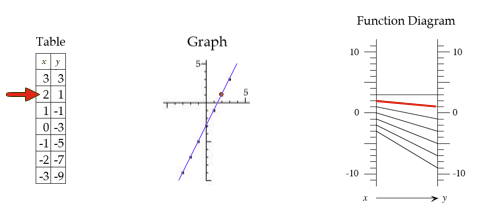Famously, functions can be represented in multiple ways: formula, graph, table. Less famously, function diagrams. These multiple representations offer multiple learning opportunities. On this page, I share some of the many lessons and activities I developed on the theme of recognizing functions.
The basics: Guess My Function
- From graph to formula: Since the advent of electronic graphing, the high school math curriculum has included a greater emphasis on the multiple representations of functions, including especially graphing. That has been a welcome development, but in my view insufficient, and not always well executed. I wrote about the pedagogy of using electronically generated graphs in
- Make These Designs
- From table to formula: During my decades as a high school math teacher, I developed a fair amount of curriculum around the idea of recognizing functions from data points, a basic ingredient in mathematical modeling.
- Functions from Tables — a blog post providing an overview of this topic, grades 4-11
- Constant Sums, Constant Products — middle school to teachers' mathematics.
- `n^(th)` Power Variation | Teachers' Guide — a high school unit
- From geometry to formula:
- Doctor Dimension — middle school to calculus
- From experiment to formula:
- Perspective — inverse variation
- Rolling Dice — exponential functions
- From function diagram to formula:
- Nine Function Diagrams — "one-step" operations
- Sixteen Function Diagrams — `y=mx+b`
- Six Function Diagrams (Algebra 2) | Eight Function Diagrams (Precalculus)
- Name That Function! — interactive version of "Eight Function Diagrams"
